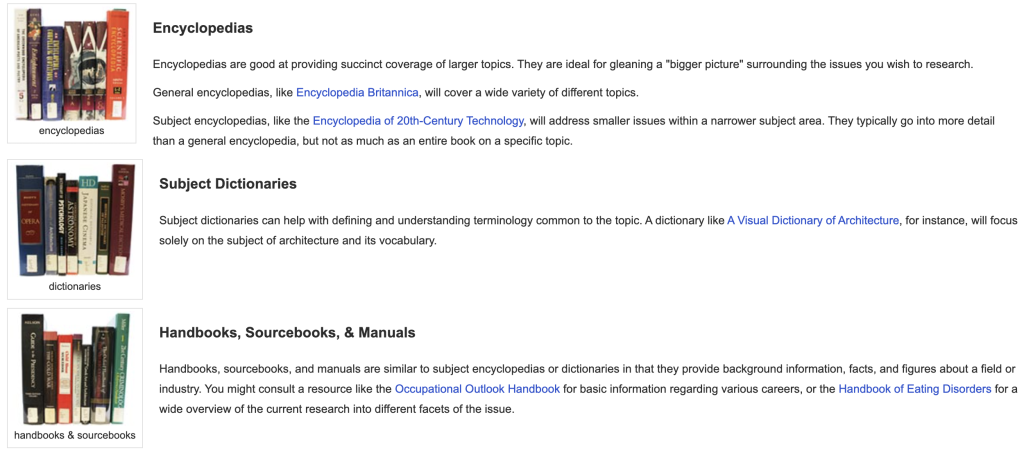1. Types of Sources

Another information category is called publication mode and has to do with whether the information is
- Firsthand information (information in its original form, not translated or published in another form).
- Secondhand information (a restatement, analysis, or interpretation of original information).
- Third-hand information (a summary or repackaging of original information, often based on secondary information that has been published).
The three labels for information sources in this category are, respectively, primary sources, secondary sources, and tertiary sources. Here are examples to illustrate:
| Primary Source
(Original, Firsthand Information) |
Carpenter, F. B.. Six Months at the White House with Abraham Lincoln. The Story of a Picture. By F. B. Carpenter., 1866. http://name.umdl.umich.edu/ACK7424.0001.001.
A memoir written in 1866 by a painter of Lincoln who lived at the White House with Lincoln during the Civil War.
|
| Secondary Source
(Secondhand Information) |
Guelzo, Allen C. Fateful Lightning: A New History of the Civil War and Reconstruction. New York, UNITED STATES: Oxford University Press USA – OSO, 2012. http://ebookcentral.proquest.com/lib/spenceschool/detail.action?docID=886542.
Secondary source scholarly book written by a historian Allen Guelzo. Guelzo cites Carpenter’s memoir in his book as primary source evidence. |
| Tertiary Source
(Third-hand Information) |
Gillis, Delia C. “Reconstruction.” Encyclopedia of the Age of Revolution and Empire (1750 to 1900). Facts On File, 2016. Accessed August 1, 2022. online.infobase.com/Auth/Index?aid=104009&itemid=WE53&articleId=244826.
Encyclopedia article about reconstruction. |
When you make distinctions between primary, secondary, and tertiary sources, you are relating the information itself to the context in which it was created.
Primary Sources – Because it is in its original form, the information in primary sources has reached us from its creators without going through any filter. We get it firsthand. Here are some examples that are often used as primary sources:
- Any literary work, including novels, plays, and poems.
- Breaking news.
- Diaries.
- Advertisements.
- Music and dance performances.
- Eyewitness accounts, including photographs and recorded interviews.
- Artworks.
- Data.
- Blog entries that are autobiographical.
- Scholarly blogs that provide data or are highly theoretical, even though they contain no autobiography.
- Artifacts such as tools, clothing, or other objects.
- Original documents such as tax returns, marriage licenses, and transcripts of trials.
- Websites, although many are secondary.
- Buildings.
- Correspondence, including email.
- Records of organizations and government agencies.
- Journal articles that report research for the first time (at least the parts about the new research, plus their data).
Secondary Source – These sources are translated, repackaged, restated, analyzed, or interpreted original information that is a primary source. Thus, the information comes to us secondhand, or through at least one filter. Here are some examples that are often used as secondary sources:
- All nonfiction books and magazine articles except autobiography.
- An article that critiques a novel, play, painting, or piece of music.
- An article that synthesizes expert opinion and several eyewitness accounts for a new understanding of an event.
Tertiary Source – These sources further repackage the original information because they index, condense, or summarize the original.
Typically, by the time tertiary sources are developed, there have been many secondary sources prepared on their subjects, and you can think of tertiary sources as information that comes to us “third-hand.” Tertiary sources are usually publications that you are not intended to read from cover to cover but to dip in and out of for the information you need. You can think of them as a good place for background information to start your research but a bad place to end up. Tertiary sources should be consulted throughout the research process to “clarify terms and concepts association with your topic and to provide basic facts, statistics, and referrals to authoritative secondary sources.”[1]
Tertiary sources provide the following:
- summary information
- definitions
- names of individuals associated with an event
- dates and places
- facts
- timelines
- bibliographies and sources for further readings.
Here are some examples that are often used as tertiary sources:
- Almanacs.
- Dictionaries.
- Guide books, including the one you are now reading.
- Survey articles.
- Timelines.
- Bibliographies.
- Encyclopedias, including Wikipedia.
- Most textbooks.
Tertiary sources are usually not acceptable as cited sources in college research projects because they are so far from firsthand information. That’s why most professors don’t want you to use Wikipedia as a citable source: the information in Wikipedia is far from original information.
The Details Are Tricky— A few things about primary or secondary sources might surprise you:
- Sources become primary rather than always exist as primary sources.
It’s easy to think that it is the format of primary sources that makes them primary. But that’s not all that matters. So when you see lists like the one above of sources that are often used as primary sources, it’s wise to remember that the ones listed are not automatically already primary sources. Firsthand sources get that designation only when researchers actually find their information relevant and use it.
For instance: Records that could be relevant to those studying government are created every day by federal, state, county, and city governments as they operate. But until those raw data are actually used by a researcher, they cannot be considered primary sources.
Another example: A diary about his flying missions kept by an American helicopter pilot in the Vietnam War is not a primary source until, say, a researcher uses it in her study of how the war was carried out. But it will never be a primary source for a researcher studying the U.S. public’s reaction to the war because it does not contain information relevant to that study.
- Primary sources, even eyewitness accounts, are not necessarily accurate. Their accuracy has to be evaluated, just like that of all sources.
- Something that is usually considered a secondary source can be considered a primary source, depending on the research project.
For instance, movie reviews are usually considered secondary sources. But if your research project is about the effect movie reviews have on ticket sales, the movie reviews you study would become primary sources.
- Deciding whether to consider a journal article a primary or a secondary source can be complicated for at least two reasons.
Despite their trickiness, what primary sources usually offer is too good not to consider using because:
- They are original. This unfiltered, firsthand information is not available anywhere else.
- Their creator was a type of person unlike others in your research project, and you want to include that perspective.
- Their creator was present at an event and shares an eyewitness account.
- They are objects that existed at the particular time your project is studying.
- Jenny L. Presnell, The Information-literate Historian: A Guide to Research for History Students, 3rd ed. (New York, NY: Oxford University Press, 2019), 29. ↵
- Seminole State College Library, "The Information Timeline," Research Foundations, last modified June 21, 2022, accessed September 12, 2022, https://libguides.seminolestate.edu/researchfoundations/informationtimeline. ↵

